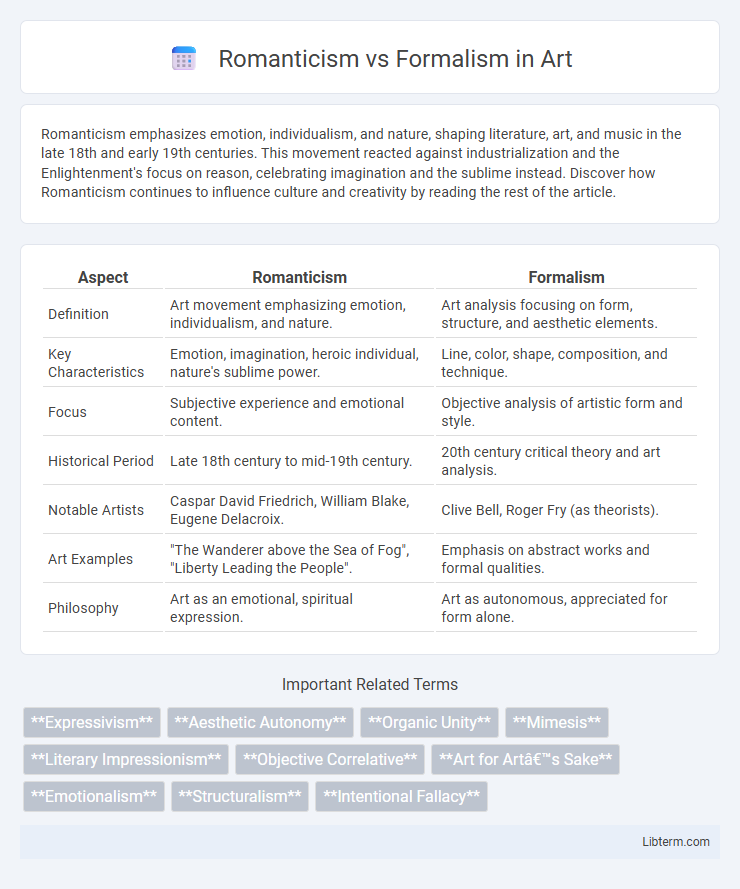Romanticism emphasizes emotion, individualism, and nature, shaping literature, art, and music in the late 18th and early 19th centuries. This movement reacted against industrialization and the Enlightenment's focus on reason, celebrating imagination and the sublime instead. Discover how Romanticism continues to influence culture and creativity by reading the rest of the article.
Table of Comparison
| Aspect | Romanticism | Formalism |
|---|---|---|
| Definition | Art movement emphasizing emotion, individualism, and nature. | Art analysis focusing on form, structure, and aesthetic elements. |
| Key Characteristics | Emotion, imagination, heroic individual, nature's sublime power. | Line, color, shape, composition, and technique. |
| Focus | Subjective experience and emotional content. | Objective analysis of artistic form and style. |
| Historical Period | Late 18th century to mid-19th century. | 20th century critical theory and art analysis. |
| Notable Artists | Caspar David Friedrich, William Blake, Eugene Delacroix. | Clive Bell, Roger Fry (as theorists). |
| Art Examples | "The Wanderer above the Sea of Fog", "Liberty Leading the People". | Emphasis on abstract works and formal qualities. |
| Philosophy | Art as an emotional, spiritual expression. | Art as autonomous, appreciated for form alone. |
Understanding Romanticism: Core Principles and Origins
Romanticism emerged in the late 18th century as a reaction against Enlightenment rationalism, emphasizing emotion, individualism, and the sublime in art and literature. Core principles include the celebration of nature, imagination, and the expression of deep personal feelings, often contrasting with the structured and rule-bound approaches of Formalism. Key figures such as William Wordsworth and Samuel Taylor Coleridge championed the movement's focus on creativity and intuition over strict adherence to classical forms.
Defining Formalism: Key Tenets and Historical Context
Formalism emphasizes the intrinsic features of a text, such as structure, style, and literary devices, as the primary means to interpret meaning, largely excluding external contexts like author intent or historical background. Rooted in early 20th-century Russian Formalism and later developed in New Criticism, this approach values close reading to uncover how a work's form shapes its content. Key tenets include analyzing narrative techniques, rhyme schemes, and imagery to understand literature as an autonomous, self-contained system.
Major Proponents of Romanticism and Formalism
Major proponents of Romanticism include William Wordsworth, Samuel Taylor Coleridge, and Lord Byron, who emphasized emotion, individualism, and nature's sublime qualities in literature. Formalism, championed by Viktor Shklovsky, Roman Jakobson, and Cleanth Brooks, prioritizes the structure, language, and literary devices within a text, focusing on form over content. These contrasting perspectives shaped literary theory by valuing subjective experience versus objective analysis in narrative interpretation.
Artistic Expression: Emotion vs. Structure
Romanticism prioritizes artistic expression through intense emotion, imagination, and individual experience, emphasizing spontaneity and personal creativity. Formalism, in contrast, focuses on the structure, form, and technical elements of art, valuing order, balance, and adherence to established artistic principles. The tension between Romantic emotion and Formalist structure defines much of the debate in art theory, highlighting the contrast between feeling-driven creation and rule-based composition.
Literary Interpretation: Imagination versus Technique
Romanticism prioritizes imagination, emphasizing emotional depth, individual creativity, and the sublime experience in literary interpretation. Formalism focuses on technique, analyzing structure, language, and literary devices to uncover meaning within the text itself. The contrast highlights imaginative freedom in Romanticism against the meticulous scrutiny of form in Formalism.
Romanticism and Formalism in Visual Arts
Romanticism in visual arts emphasizes emotional intensity, individual expression, and the sublime aspects of nature, often portraying dramatic scenes and vibrant colors to evoke deep feelings. Formalism prioritizes the analysis of compositional elements such as line, color, shape, and texture, focusing on the intrinsic qualities of the artwork rather than its emotional or narrative content. Romantic artists like Caspar David Friedrich explore mood and imagination, while Formalist critics emphasize the structural harmony as seen in works by artists like Piet Mondrian.
Music: Emotional Depth vs. Technical Precision
Romanticism in music emphasizes emotional depth, expressive melodies, and passionate performances that seek to convey intense personal feelings and narratives. Formalism prioritizes technical precision, structural clarity, and adherence to compositional forms, highlighting craftsmanship and intellectual rigor. The tension between these approaches shapes the interpretation and appreciation of musical works, balancing heartfelt expression with disciplined technique.
Influence on Modern Creative Movements
Romanticism's emphasis on emotion, individualism, and nature profoundly shaped modern creative movements by inspiring expressive and experimental approaches in literature, visual arts, and music. Formalism's focus on structure, technique, and aesthetic form influenced modernism and postmodernism, encouraging artists and writers to explore abstraction, formal innovation, and self-referentiality. Together, these movements laid the foundation for diverse 20th-century artistic expressions, balancing emotional depth with structural rigor.
Critical Debates and Theoretical Implications
Romanticism emphasizes emotional expression, individual creativity, and the subjective experience, contrasting sharply with Formalism's focus on intrinsic textual elements such as structure, style, and linguistic features. Critical debates center on whether literature should be analyzed through its emotional impact and cultural context or through objective, systematic examination of form and technique. Theoretical implications influence diverse interpretive strategies, shaping approaches to literary analysis and the evaluation of artistic value.
Contemporary Relevance of Romanticism and Formalism
Contemporary relevance of Romanticism lies in its emphasis on individual emotion, creativity, and subjective experience, which resonates in modern artistic and literary expressions fostering personal and cultural identity. Formalism remains vital in today's critical analysis by prioritizing structure, style, and intrinsic elements of a work, enabling objective evaluation and appreciation of artistic form independent of external contexts. Both approaches contribute uniquely to the understanding and interpretation of art and literature in contemporary scholarship and creative practice.
Romanticism Infographic

 libterm.com
libterm.com